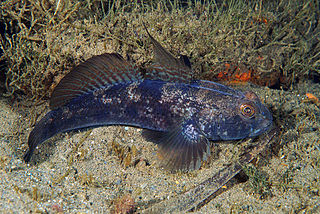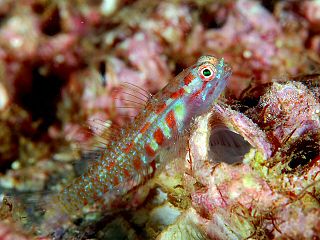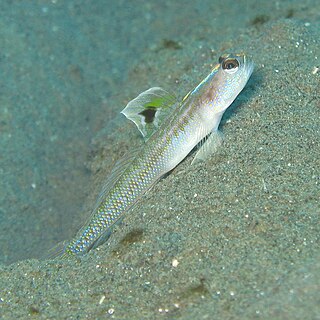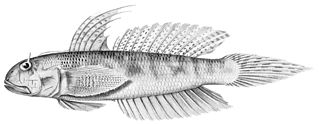
Gobiidae or gobies is a family of bony fish in the order Gobiiformes, one of the largest fish families comprising more than 2,000 species in more than 200 genera. Most of gobiid fish are relatively small, typically less than 10 cm (3.9 in) in length, and the family includes some of the smallest vertebrates in the world, such as Trimmatom nanus and Pandaka pygmaea, Trimmatom nanus are under 1 cm long when fully grown, then Pandaka pygmaea standard length are 9 mm (0.35 in), maximum known standard length are 11 mm (0.43 in). Some large gobies can reach over 30 cm (0.98 ft) in length, but that is exceptional. Generally, they are benthic or bottom-dwellers. Although few are important as food fish for humans, they are of great significance as prey species for other commercially important fish such as cod, haddock, sea bass and flatfish. Several gobiids are also of interest as aquarium fish, such as the dartfish of the genus Ptereleotris. Phylogenetic relationships of gobiids have been studied using molecular data.

Cardinalfishes are a family, Apogonidae, of ray-finned fishes found in the Atlantic, Indian, and Pacific Oceans; they are chiefly marine, but some species are found in brackish water and a few are found in fresh water. A handful of species are kept in aquariums and are popular as small, peaceful, and colourful fish. The family includes about 370 species.
Pascua is a genus of gobies native to the Pacific Ocean. The origin of the name "Pascua" is from the Spanish for "Easter" in recognition of the Easter Island range of the type specimen.

Eviota is a genus of fish in the family Gobiidae, commonly as dwarfgobies found in the Indo-Pacific region, where it is distributed from Japan to Australia and from Africa to Pitcairn Island. Species are mainly associated with coral reefs. Many of these fish are short-lived, with life cycles as brief as 3.5 weeks in the tropics. Some species are hermaphrodites and some representatives live symbiotically among the tentacles of the mushroom coral.

Amblyeleotris is a genus of fish in the family Gobiidae found throughout the Indo-Pacific region. This is the largest genus of the shrimp gobies or prawn gobies, so-called because of their symbiotic relationship with certain alpheid shrimps. The shrimp excavates and maintains a burrow used by both animals while the goby, which has far superior eyesight, acts as a lookout for predators. The shrimp maintains almost constant contact with the fish with an antenna. Fossil Amblyeleotris otoliths have been found together with alpheid shrimp remnants from as early as late early Miocene (Burdigalian) suggesting a possible mutualistic association since then.

Mugilogobius is a genus of fish in the family Gobiidae. They are found in fresh, brackish and marine water of the Indo-Pacific region. Several of the freshwater species have highly restricted distributions.

Priolepis is a genus of fish in the family Gobiidae with a cosmopolitan distribution.

Redigobius is a genus of fish in the goby family, Oxudercidae, known commonly as dualspot gobies. They are native to the western Indo-Pacific region, where they occur in estuaries and freshwater habitats just above the tidal influence.

Stenogobius is a genus of fish in the goby subfamily, Gobionellinae. They are native to fresh, brackish and marine waters along the coasts of the Indian and Pacific Oceans. They are known commonly as coastal stream gobies.

Vanderhorstia is a genus of gobies native to the Indian and Pacific oceans. The name of this genus honours the Dutch biologist Cornelius van der Horst (1889-1951) of the University of the Witwatersrand, Johannesburg, who was well known for his interest in marine biology.

Oxyurichthys microlepis, commonly known as the maned goby, is a species of goby native to tropical marine and brackish waters along the coasts of the Indian Ocean from Africa to the western Pacific Ocean where it occurs in estuaries and inshore waters to depths of about 75 metres (246 ft). It occurs in the Mekong Delta and is suspected to use the tidal flow up the river to reach as far inland as Cambodia. This species can reach a length of 13.5 centimetres (5.3 in) TL. It is of minor importance to local commercial fisheries and can also be found in the aquarium trade.

Bryaninops is a tropical Indo-Pacific genus of gobies. The genus takes its common name from the fact that it is commensal on gorgonians and black coral. The genus is further characterised by cryptic colouration.
Pseudogobiopsis is a genus of fish in the goby family, Gobiidae. They are native to fresh and brackish waters of southern and southeastern Asia. The genus is mainly distinguished by the number and arrangement of fin rays and spines, headpores, and sensory papillae, the large mouths of the males, a fleshy or bony flange on the pectoral girdle, and the shape of the genital papilla.

The Gobionellinae are a subfamily of fish which was formerly classified in the family Gobiidae, the gobies, but the 5th Edition of Fishes of the World classifies the subfamily as part of the family Oxudercidae. Members of Gobionellinae mostly inhabit estuarine and freshwater habitats; the main exception is the genus Gnatholepis, which live with corals in marine environments. The subfamily is distributed in tropical and temperate regions around the world with the exception of the northeastern Atlantic Ocean, the Mediterranean Sea, and the Ponto-Caspian region. It includes around 370 species and 55 genera: Wikipedia articles about genera list about 389 species.

Cryptocentrus, also known as Watchman gobies, and one of the genera known as shrimp gobies or prawn gobies, is a genus of gobies native to tropical marine waters of the Indian and Pacific oceans.

Oxyurichthys is a genus of fish in the subfamily Gobionellinae, commonly known as arrowfin gobies. They are distributed in the tropical and subtropical Indian and Pacific Oceans; one species is also known from the western Atlantic Ocean. Most species live in shallow waters under 10 meters deep over fine substrates such as silt.

Pleurosicya is a genus of gobies native to reef environments of the Indian Ocean and the western Pacific Ocean.

Stigmatogobius is a genus of fish in the goby subfamily, Gobionellinae. It is distributed in the Indo-Pacific region, specifically the Indo-Malayan zone. Species can be found along the substrate or hiding in plant litter in freshwater habitat, and sometimes in estuary habitat, such as mangrove stands.
John Ernest "Jack" Randall was an American ichthyologist and a leading authority on coral reef fishes. Randall described over 800 species and authored 11 books and over 900 scientific papers and popular articles. He spent most of his career working in Hawaii. He died in April 2020 at the age of 95.
Gnatholepis gymnocara, the Nakedcheek sandgoby, is a small species of ray-finned fish in the subfamily Gobionellinae. The Naked cheek sandgoby is found primarily in the Indian Ocean along the coast of Australia.
















